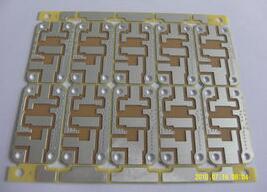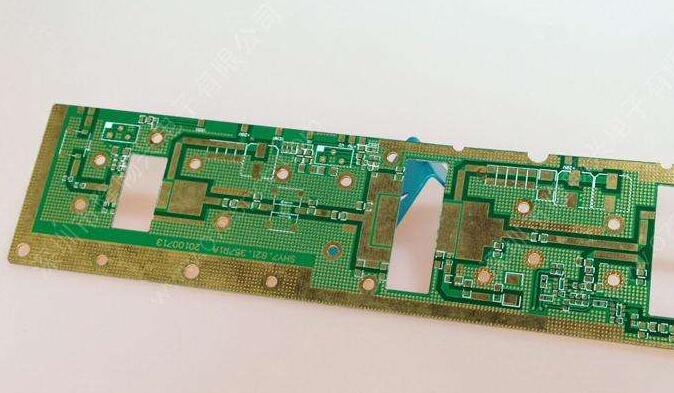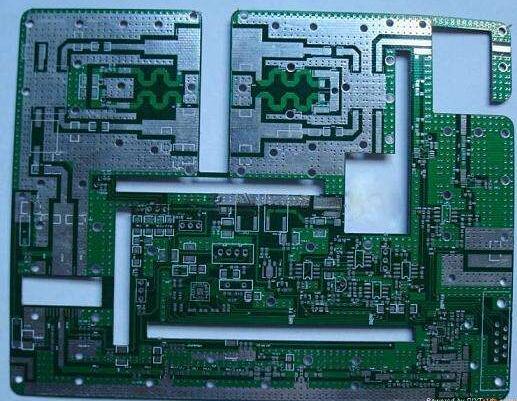Nowadays, science and technology are developed, and the electronic communication industry is developing rapidly. Therefore, new generation development requires high-frequency substrates, and high-frequency circuit boards have an impact on our lives. High-frequency signals of high-frequency circuits are slowly affecting our lives. . This article mainly introduces the high-frequency board process flow, which is analyzed in detail from 18 aspects such as blanking, drilling, surface treatment (soaking high-frequency perfecting agent), hole formation, graphic production transfer, graphic electroplating, etc. Follow Xiaobian to find out about it.

(1) According to the process requirements, check whether the high-frequency materials such as sheet type, copper foil thickness, blanking material size, sheet thickness and dielectric constant are correct.
(2) When the same model, select different materials at the same time production, should be marked, and consistent with the instructions to identify the production process until FQC separation;
Second, drilling(1) Use a new drill and do not allow the use of an over-ground drill;
(2) Drilling holes refer to the high-frequency plate drilling parameters in the drilling operation file;
(3) Special attention should be paid to the phenomenon of kinking when drilling, which can be overcome by adjusting the vacuum level, presser foot force and retracting speed;
(4) Thick aluminum plates and high-density pads are used for drilling to prevent peaks from being generated.
(5) Surface burrs and blunt fronts are generally not allowed to be ground (specially available 1500 mesh water sandpaper is used for fine grinding) so new drilling nozzles must be used for drilling and attention should be paid to drilling parameters;
(6) The board material is soft and fragile, please use soft paper to isolate and transfer the order. At the same time, the surface of the copper foil as an anti-oxidation film is not easy to remove fingerprints, and must not touch the board surface with bare hands.
(7) For ARLON plates AD255, AD350, Rogers R03003, R03010, R03203 and other special materials (absorbent), 150C+5C high temperature baking is required after drilling for 4 hours to dry the internal moisture of the plate;
Third, the surface treatment (soaking high-frequency whole-hole agent)(1) The board material is soft and fragile, must be fixed when put on the shelf, and must be slowly translated during swinging, otherwise it is easy to damage the plate;
(2) The multi-layer high-frequency plate and double-slots with slots greater than 2.0mm need to be etched first;
(3) High-frequency boards (except Rogers hydrocarbon sheets R04233, R04350, and R04003) need to be soaked with high-frequency anti-fouling agent. When the multilayer boards need to be treated with high-frequency correcting agent, they must be etched in the baking sheet 130. Degree 2 hours;
(4) Ensure that the surface of the plate dries into the cylinder when soaking the high-frequency solid agent; (ie, the process is: concave etching + baking plate + high-frequency perfecting agent + copper sink)
Fourth, the holeDue to the poor wettability of high-frequency plate PTFE material, surface treatment must be performed first to complete chemical copper deposition. The process can be as follows:
(1) When the copper sinks, the concentration of potions can be increased and the copper sinking time can be prolonged;
(2 Double plated plywood shall be used in principle for thick copper plating and pattern plating, but it shall be determined according to the position of the drill hole, the upper frame, the plywood, and the size of the auxiliary edge other than the peripheral hole when inserting or adding, and shall not be damaged. Substrate
(3) The material of the high-frequency board is soft and fragile. When the thickness of the board is thin, the oscillating switch may not be turned on to avoid intermittent short-circuit burning of the cathode and the anode. The operator should observe the indication of the current meter at any time.
(4) The production of high-frequency plates requires the ultrasonic shut-off of the sinker copper line to be produced.

(1) When the operator first checks the first board, he should use a hundredfold microscope to strictly check the width and distance of the microstrip;
(2) In order to prevent the deformation of the microstrip line, it is necessary to determine the exposure parameters and the development parameters according to the first board;
(3) When there are many twisting lines in the high-frequency board, use the hinged yin and yang beat or parallel exposure machine to enhance the alignment accuracy;
Six, graphic plating(1) The tin spray plate shall be determined according to the customer's requirements. If there is no requirement, it will be plated with copper for 60 minutes. The DK will be 1.6-1.8 A/dm. The thickness of the copper layer is controlled at 20-25um, tin plating is 10-15 minutes, and the DF is 1.5 A/dm';
(2) Nickel plated/gold plated according to customer's requirements. If not required, it will be plated with copper for 20 minutes, DK will be at 1.6-1.8A/dm, nickel plated for 12-15 minutes (as thin as possible), DK will use 1.8-2.0 A. / Dm ".
Seven, film(1) The film must be thoroughly cleaned;
(2) The tin plate must be controlled to remove the film concentration (5-10% NaOH), temperature 50-65C, do not overlap when the film is removed, to prevent tin free, film removal is not complete, resulting in lines of etched dog teeth, glitches .
Eight, two diamond(1) Since the high-frequency plate (except Rogers hydrocarbon plates R04233, R04350, and R04003) is easily deformed, the two diamonds are removed before the film is etched to prevent misalignment after the etching and lead to misalignment of the second drill.
Nine, etching(1) Etching the first board and self-checking the line width of the microstrip, meeting the requirements of mass production, not meeting the requirements of the relevant personnel to adjust and confirm;
(2) Do not retreat the tin and send it to the inspection before inspection if the tin spray/embedded gold plate is etched.
(3) For high-frequency boards (except Rogers hydrocarbon sheets R04233, R04350, R04003) The boards cannot be ground after etching.
Ten, etching inspection(1) Check the line width of the microstrip line strictly with a magnification lens
(2) Microstrip lines and nearby copper at 2.54mm must be removed;
(3) The residual copper layer on the microstrip line shall not be removed with a blade, but may be etched again to avoid scrapping.
(4) The microstrip line should be flat and smooth, without burrs, dog teeth, or pits;
(5) For high-frequency boards (except for Rogers hydrocarbon sheets R04233, R04350, R04003) The boards cannot be ground after etching.
(6) AD255 and AD350 in PTFE material and RO3003\R03010\R03203. After etching and inspection, the substrate must be milled and milled to remove the substrate around the edge of 2-3mm. After milling, the baking sheet 150 is plated for 2 hours to prevent after soldering. The substrate blisters after baking or spraying.

(1) In addition to satisfying the PP thickness requirements, under the condition that the adjacent layers of PP are uniformly distributed and the latitude and longitude are consistent, the influence of the interlayer dielectric thickness on the characteristic impedance needs to be considered;
(2) In the PTFE material AD255 and AD350 and RO3003\R03010\R03203, etc., the blind hole plate in the inner layer needs to mill the copper on the edge of the process to expose the substrate before lamination. The plate is kept for 2 hours to prevent foaming of the substrate due to lamination. After browning, it is necessary to re-insert the 120C baking sheet for 1 hour before laminating.
(3) For high-frequency boards (except Rogers hydrocarbon sheets R04233, R04350, R04003) Plates cannot be ground before or after browning.
Twelve, solder mask(1) Pretreatment of gold-plated plates: Use a gold plate cleaning machine to clean and dry a low temperature (75% soil and 5C). After 30 minutes of pre-heating, cool down to room temperature (more than half an hour). Apply a solder mask (do one solder mask)
(2) PTFE high-frequency (without hydrocarbon sheet R04233, R04350, R04003) Spray/immersion gold/paste sheet pretreatment:
A: Tin-plating and tin-removal are also required to apply anti-corrosion soldering. Direct acid drying before soldering is performed. The first solder mask must not be ground. B: Tin-plating is not tin-reduced and not-printed, but before soldering. The acid can be directly ground and dried;
C: Tin-plating does not retreat tin but also India-based soldering, cleaning and drying before soldering can be (can not wear plates);
D: In the above A, c under certain conditions need to see whether the process sheet to the next two solder mask, if the first solder mask before the first use of high pressure water washing and drying can be, (required to do double resistance welding The first time the solder mask is used, the rework film must be used for the first solder mask.) The first item of C solder mask before the second solder mask can be acid-washed, and the A-piece must be over-milled.
E: Solder resisting printing at low temperature (75°C and 5°C) before printing and pre-altering for 30 minutes;
(3) PTFE high-frequency board (excluding hydrocarbon sheet R04233, R04350, R04003) The sheet metal sprayed/embedded gold board needs to be soldered twice, and the sinking board needs to be soldered three times.
(4) Do only one high-frequency welding plate to add 50ml of boiling water, the first time to do the second solder resistance to open the oil is 120ml, the second and third open oil are 50ml;
(5) After standing for more than 30 minutes after the Xu resistance welding, it shall be pre-baked again to ensure that the solder resist ink and the plate are cross-linked according to the thickness, thinness, largeness and small time;
(6) Bare copper: The first solder mask after pre-tanning is exposed with the rework film (positioning on the substrate requires resistance welding);
(7) Before developing and after exposure, be sure to stand for 15 minutes before developing;
Thirteen, Hou YiA: Gold plated
Send silk screen after printing (section 煸) 75C pre-load for 30 minutes and then in 120C 炯 30 minutes, in 155C after 煸 60 minutes (step 炯 in the same furnace to complete), when the plate is fixed plate; B: plating Tin plate: pre-baking for 75C30 minutes, cooling the plate with a 155C30 minute after the second seal, and QC checking the tenth time (75C30 minutes, 120C30 minutes, 155C60 minutes).
XIV. Spray tin/immersion goldA, TP-2 sheet can not be spray process, only 36W thermostatic electric iron assembly;
B, spray tin first board to check whether the solder strip off, blistering; whether the tin surface is flat, whether the hole wall burst hole; substrate and copper layer is layered, blisters, etching characters off.
C. When spraying tin, it should be baked on board 155 persons 5C 30min after spraying hot tin, to prevent the burst hole.
D, do not do soldering tin spray plate sprayed with 155 earth 5C before baking 4 hours;

(1) curing conditions: 155 soil 5C baking sheet 30min
(2) PTFE high-frequency board (excluding hydrocarbon sheet R04233, R04350, R04003) The board is not solder-resist but the board must not be scratched when characters need to be printed to prevent the characters from falling off.
(3) Requires solder mask and characters to be printed on the substrate. It is necessary to communicate with the customer. Since the characters are not printed after the second solder mask is applied, customers are advised to do the etching of copper characters in principle. Large, to prevent shedding) or character design printed on the solder mask.
Sixteen, shape processing(1) PTFE material is not recommended for molding with V-CUT;
(2) The parameters of the seesaw are as per the high frequency board requirements for electric milling work files.
(3) MILLER milling cutters cannot be used for electric milling, special milling cutters are required, and compaction is used to strengthen the dust collection effect. If the knife is dropped, it needs to be cut by the knife. If there is still fiber on the edge, the blade must be removed. ;
Seventeen, finished product inspection ten children, packaging(1) Unqualified panels shall be sealed separately for relevant routine tests. If the customer emphasizes that unqualified semi-finished products, finished boards, and incoming materials are returned to customers, they shall be separately packaged and clearly marked and delivered to the finished product warehouse;
(2) Panels that require long-distance delivery are surrounded by foam panels.
Educational projectors are mainly aimed at classroom teaching by school teachers; traditional projectors are not easy to carry. Due to the naughty students in school classrooms, projectors are not safe to place in classrooms and are easily damaged by students. The portability of educational micro-projectors makes up for teaching Vacancy, it is convenient for teachers to give lectures and only need to store the materials in the projector and show them to students for teaching, saving the trouble of textbooks and handwriting with pens and chalks. Its general weight will not exceed 0.2Kg, and some do not even need fan cooling or ultra-small silent fan cooling.
Educational projectors need to have:
1. Clear handwriting Educational projectors most often display text and images, at least a resolution of 1024*768 or more, and a contrast ratio of more than 3000 lumens, so that students in the back row can see the projection clearly
2. Short-focus large screen;
3. Accurate color;
4. Easy operation;
5. Features such as multiple connection methods.
education projector,education use projector,smart education projector,best education projectors,projector for education
Shenzhen Happybate Trading Co.,LTD , https://www.szhappybateprojectors.com
